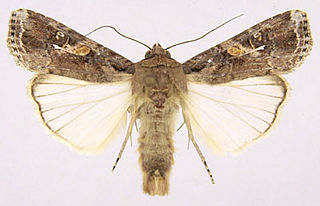 W
WThe fall armyworm is a species in the order Lepidoptera and is the larval life stage of a fall armyworm moth. The term "armyworm" can refer to several species, often describing the large-scale invasive behavior of the species' larval stage. It is regarded as a pest and can damage and destroy a wide variety of crops, which causes large economic damage. Its scientific name derives from frugiperda, which is Latin for lost fruit, named because of the species' ability to destroy crops. Because of its propensity for destruction, the fall armyworm's habits and possibilities for crop protection have been studied in depth. It is also a notable case for studying sympatric speciation, as it appears to be diverging into two species currently. Another remarkable trait of the larva is that they practice cannibalism as a disease control mechanism.
 W
WCallionima gracilis is a species of moth in the family Sphingidae. It was originally described by Karl Jordan as Hemeroplanes gracilis in 1923. It is endemic to Cuba.
 W
WCallionima ramsdeni is a species of moth in the family Sphingidae which is known from Cuba. It was originally described by Benjamin Preston Clark in 1920.
 W
WElaphria agrotina is a moth of the family Noctuidae first described by Achille Guenée in 1852. It is found from North America, through Central America, the Antilles and Cuba to Brazil and Argentina.
 W
WElaphria basistigma is a moth of the family Noctuidae. It is found on the West Indies.
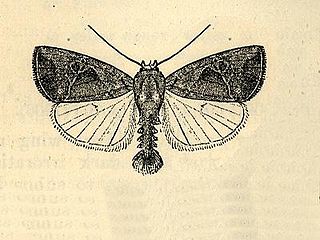 W
WElaphria nucicolora, the sugarcane midget, is a moth of the family Noctuidae. The species was first described by Achille Guenée in 1852. It is found from the south-eastern United States, through Guadeloupe, Jamaica and Puerto Rico to tropical South America. It is also present on the Hawaiian islands of Oahu, Maui and Hawaii.
 W
WElaphria subobliqua is a moth of the family Noctuidae. It is found from Mexico to Paraguay and on Jamaica, Cuba and Puerto Rico. It was first reported from Texas in 2004.
 W
WEriopyga crista is a moth of the family Noctuidae found from the southern United States through Central America to South America and on the Antilles.
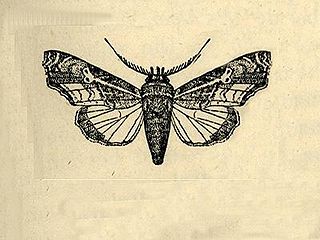 W
WEutelia ablatrix is a moth of the family Noctuidae. It is found from Central America to Paraguay and on the Antilles.
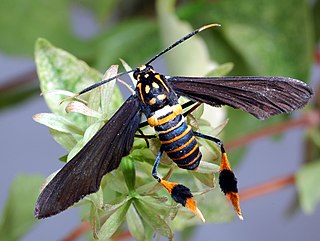 W
WHorama panthalon, the Texas wasp moth, is a moth of the subfamily Arctiinae. The species was first described by Johan Christian Fabricius in 1793. It is found in South America, Central America, Mexico, the Antilles and southern United States.
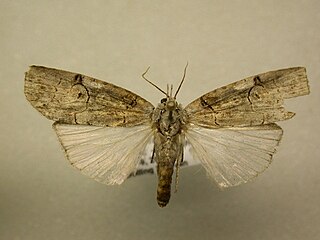 W
WIscadia aperta is a moth of the family Nolidae. It is found in Arizona and Texas, Central America, South America and the Antilles.
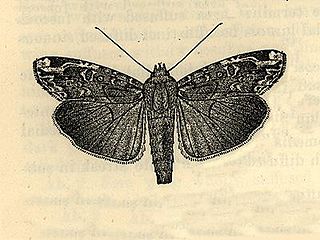 W
WMagusa orbifera is a moth of the family Noctuidae. It is found from southern Florida through the Florida Keys to the Caribbean. The species is commonly known as Orbed Narrow-wing, but this name may also be applied to Magusa divaricata, which was treated as a synonym until recently.
 W
WPeridroma saucia, the pearly underwing or variegated cutworm, is a moth of the family Noctuidae. The species was first described by Jacob Hübner in 1808. It is found in North and South America, Europe, Asia and Africa. The variegated cutworm feeds on many plants, especially common fruits and vegetables. The moth undergoes two to four generations per year. The development of the moth slows in colder temperatures, indicative of its migratory nature. All stages of the life cycle have a developmental threshold for temperature. The moth is known to migrate to the northern regions during warmer months, returning to the southern regions when the climate becomes colder.
 W
WPerigonia divisa is a moth of the family Sphingidae. It is known from Cuba.
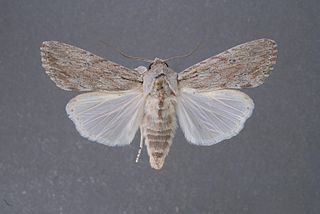 W
WSpodoptera albula is a moth of the family Noctuidae found from the southern United States, south to South America.
 W
WSpodoptera dolichos, the dolichos armyworm moth or sweetpotato armyworm moth, is a moth of the family Noctuidae. The species was first described by Johan Christian Fabricius in 1794. It is found from the southern United States, south through Costa Rica to South America, as far south as Argentina. In the United States, it may occur as far north as Kentucky and Maryland.
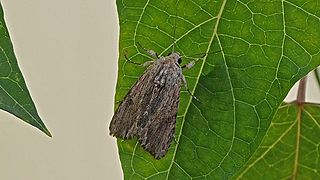 W
WSpodoptera eridania is a moth that is known to be a pest. They are one of the most important defoliators in the tropical and subtropical regions of the western hemisphere that feed heavily on plants while they are young, often resulting in skeleton leaves on their food plants. They are also heavy feeders on tomato in Florida. There is a lot of development in producing pesticides against the S. eridania, specifically a neem-based pesticide that can result in smaller and prolonged development. The wingspan is 33–38 mm. Adults are on wing year-round. The larvae feed on various weeds but prefer Amaranthus species and Phytolacca americana.
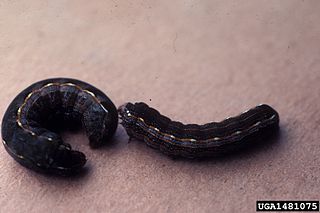 W
WSpodoptera latifascia, commonly known as the lateral-lined armyworm, garden armyworm, or velvet armyworm, is a moth of the family Noctuidae found from Central America and the Antilles into North America. Previously S. cosmioides, was treated as a synonym S. latifascia however it was restored as a valid species in Pogue (2002).
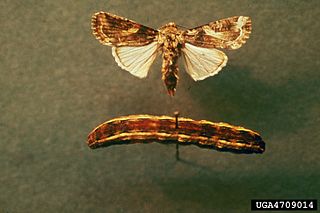 W
WSpodoptera ornithogalli is a moth of the family Noctuidae.
 W
WSpodoptera pulchella, the Caribbean armyworm moth, is a moth of the family Noctuidae found in Florida and Texas, Central America, the Greater Antilles, and the Bahamas. It was first described by Gottlieb August Wilhelm Herrich-Schäffer in 1868.
 W
WXanthopastis regnatrix is a moth of the family Noctuidae. It occurs in the United States, where it is found from North Carolina to Texas and south to Florida. Strays have been recorded as far north as coastal New York, and inland as far north as Kentucky.